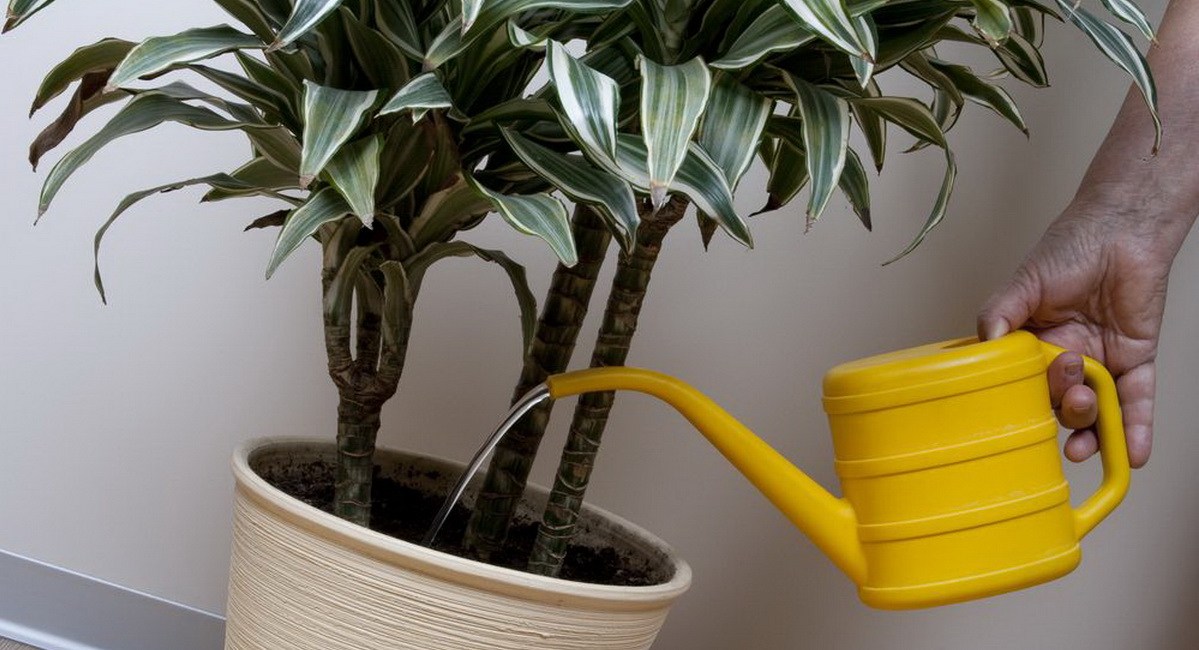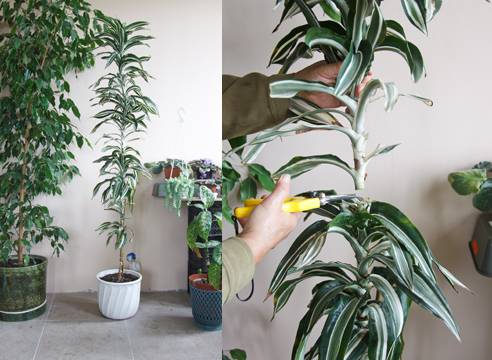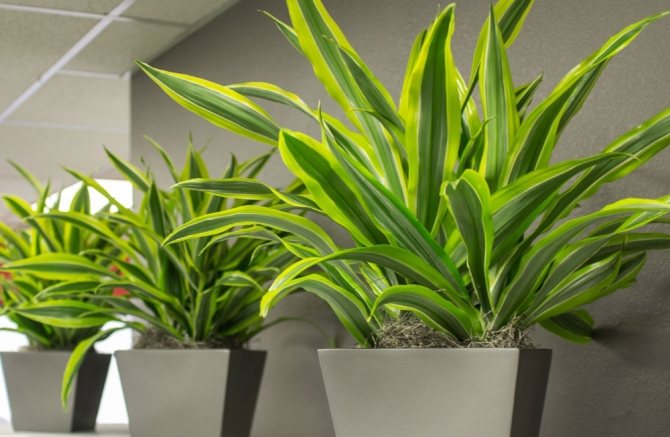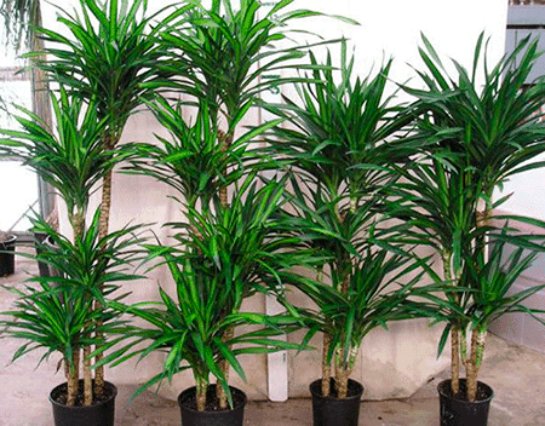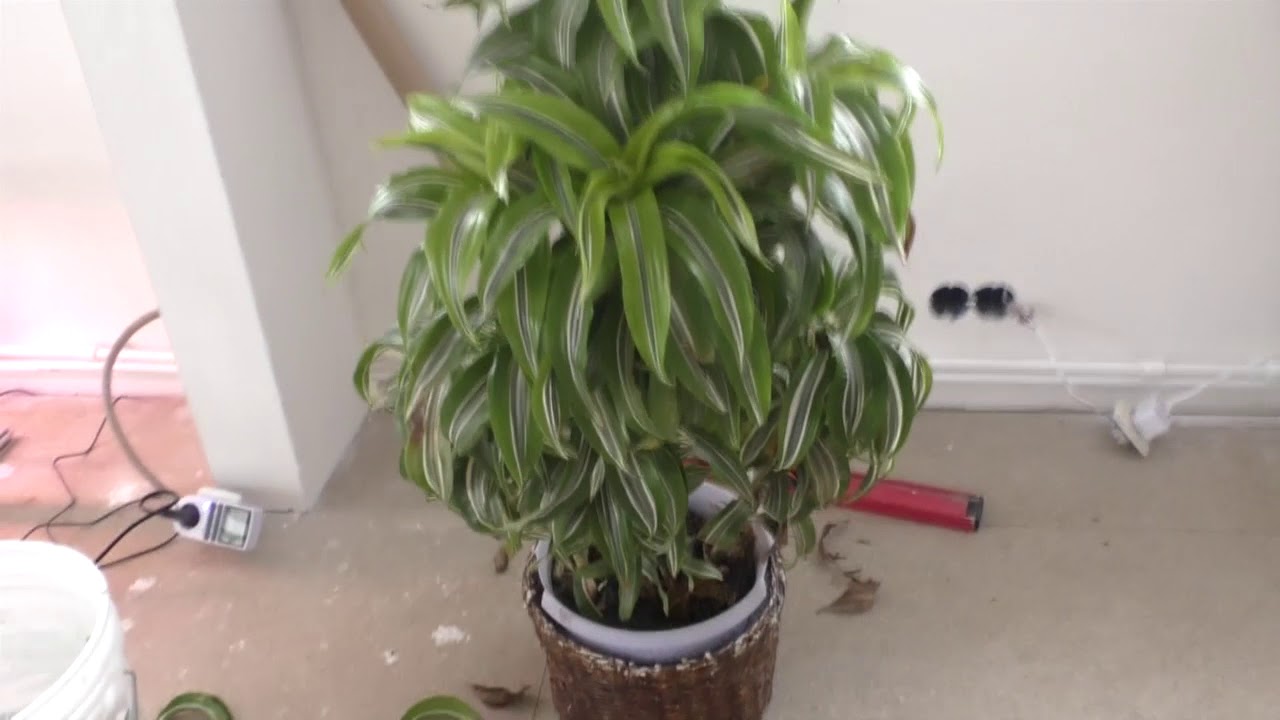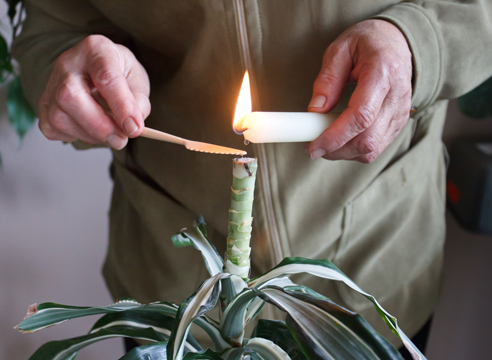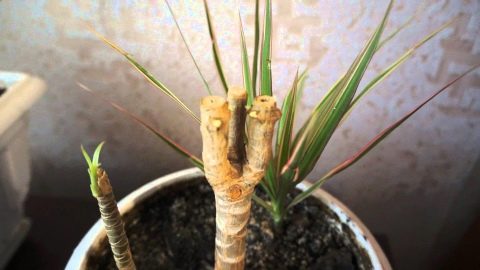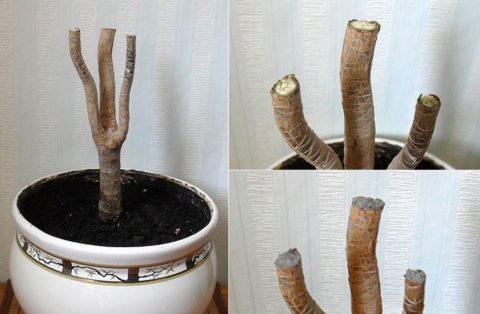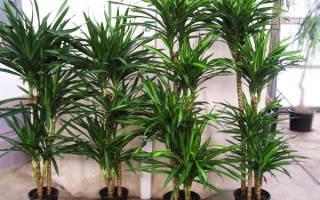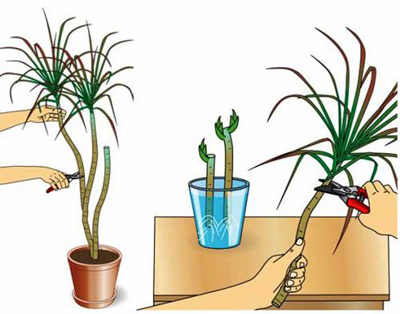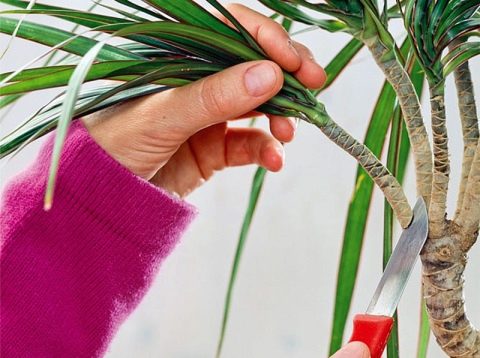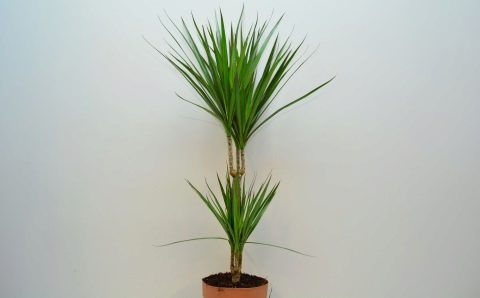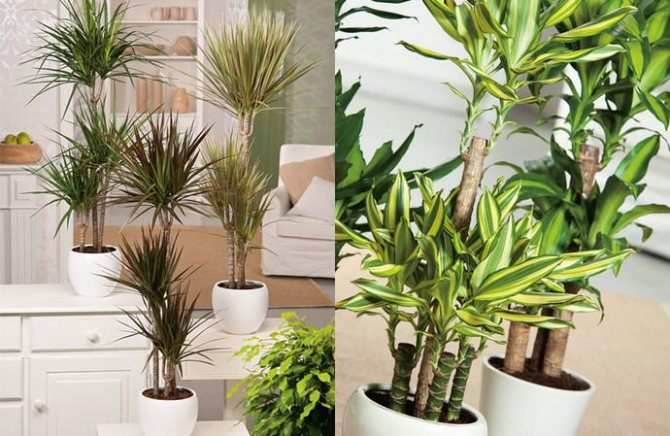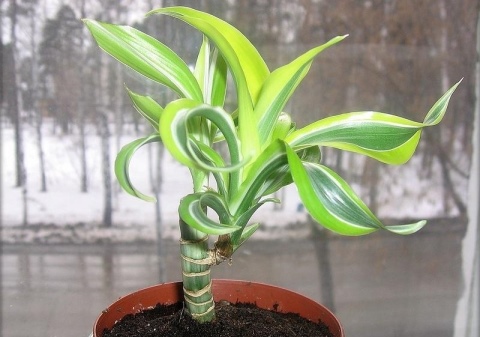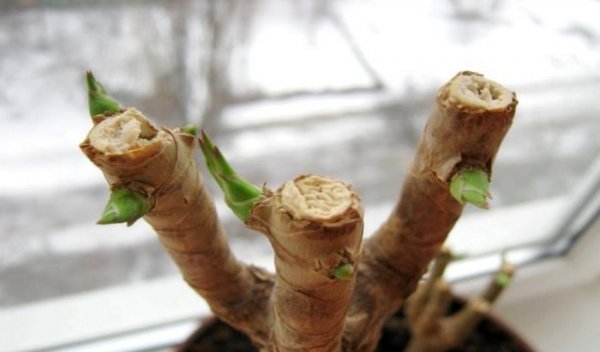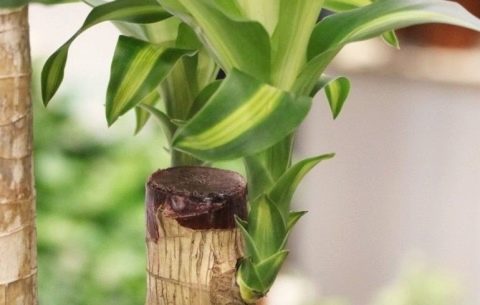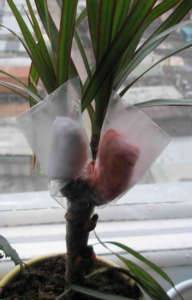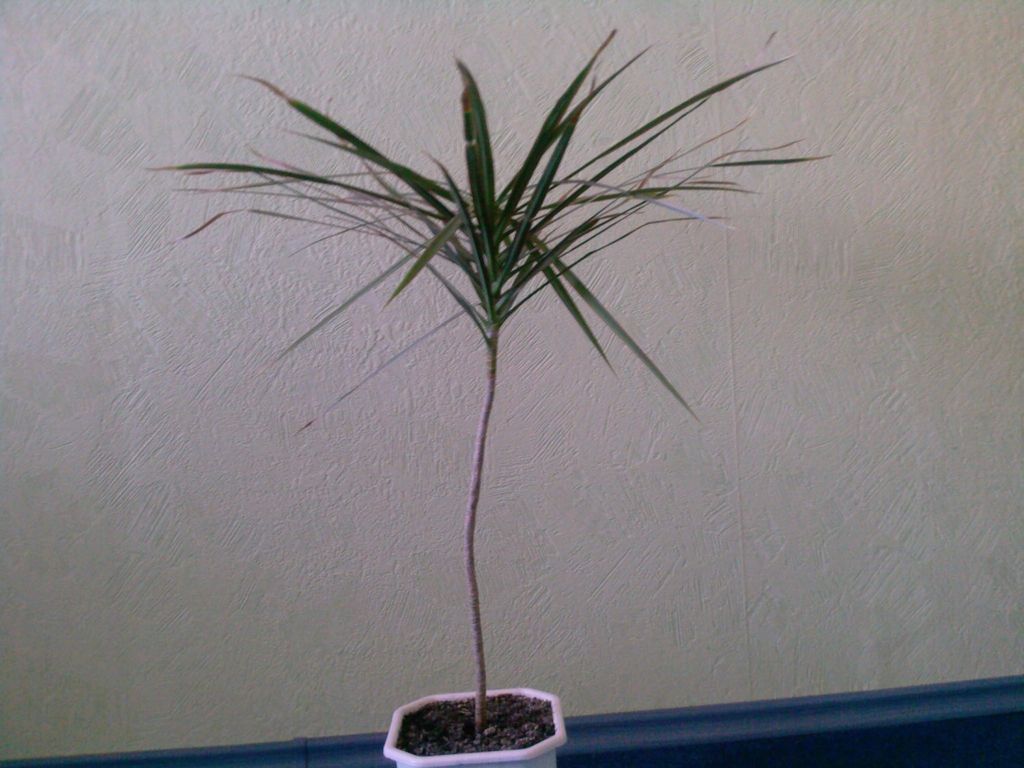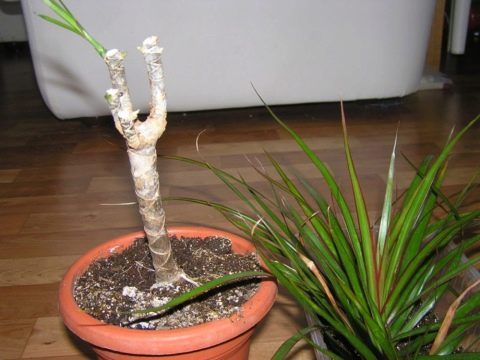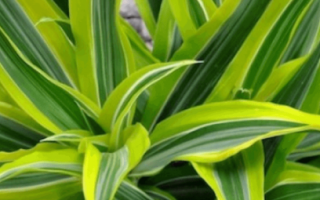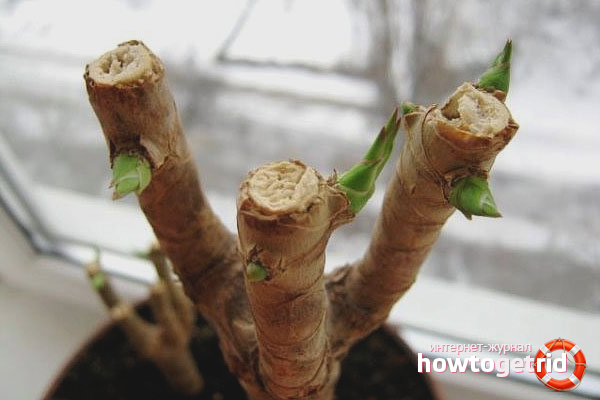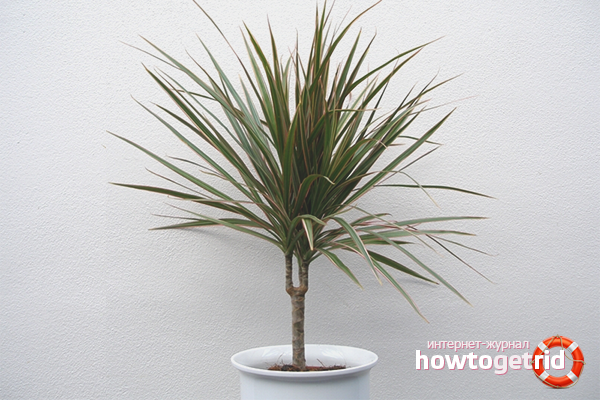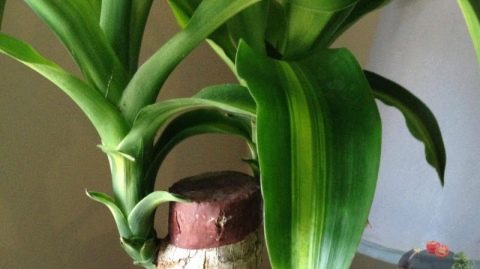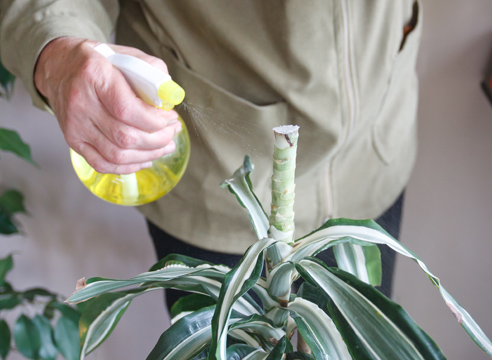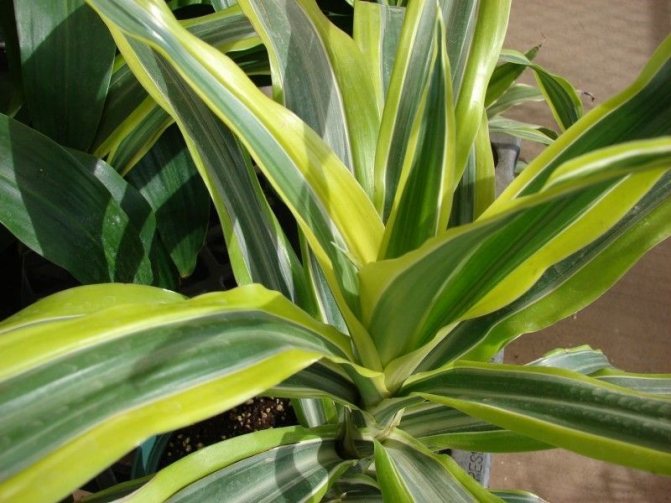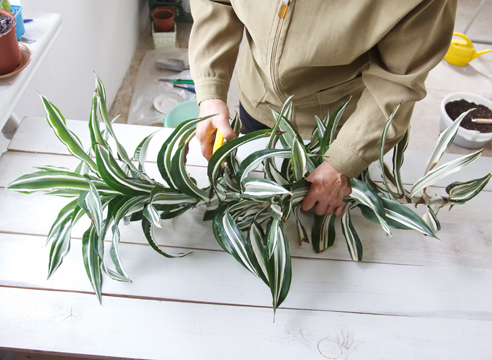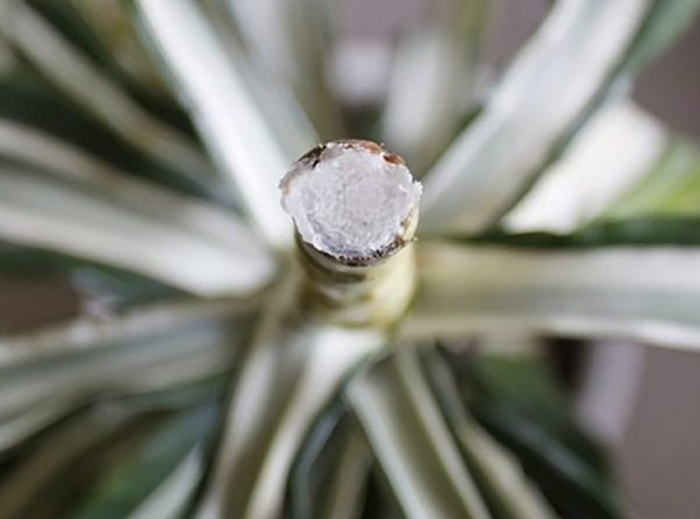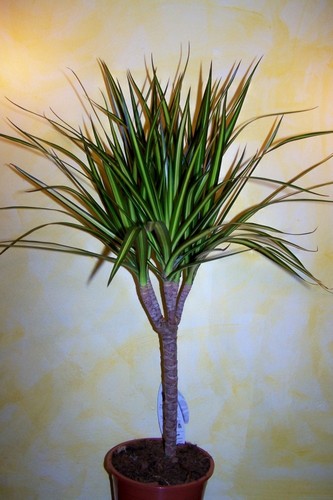How to properly trim dracaena at home?
First of all, you need to understand what height tree you want to get in the end. The second important factor is lighting, because future shoots will develop precisely due to the light falling on them.
The cut should be at such a level that new shoots and foliage receive a sufficient amount of sunlight.
Expert opinion
Mokhov Andrey Petrovich
Graduated from KubSAU specialty: agronomy
It is recommended to prune the dracaena at a distance of at least 30 cm from the surface of the ground, an exception may be sanitary pruning, if necessary, or pruning of an elongated stem.
For the pruning procedure, you can use a scalpel or a sharp sterile knife, scissors or a garden pruner are not recommended, as they pinch the stem and can cause unwanted damage.
You will also need a garden pitch or a more familiar paraffin candle, sphagnum moss, a water sprayer and a plastic bag.
What types of dracaena need to be cut?
At home, as a rule, the following types and varieties of dracaena are grown:
- Reflexa or Dracaena Unbent. It has long, pointed leaves with a striped color from dark green to yellow and beige. It has a thick stem that grows at home up to a meter in height.
- Surculosa or Dracaena Escaping. Leaves are bright green, rounded with a pointed end and an unusual mottled color. The trunk often branches, new shoots grow quickly, turning the dracaena into a voluminous fluffy bush.
- Fragrans or Fragrant Dracaena. The leaves are long, glossy up to half a meter in length, have a characteristic dark green color with light stripes. It is able to bloom at home, which explains its name.
- Marginata or Madagascar dragon tree. It is this species that is most often found and associated with a palm tree, thanks to the characteristic shape of the trunk and crown. The leaves are thin and long, of various shades of green from light green to very dark, with a light or reddish border around the edge.
All types of dracaena grown at home need pruning, only its frequency differs.
Cutting time
Like all procedures that injure the plant, pruning must be carried out during the period of active growth, this is the only way to ensure that everything will be successful and the dracaena will quickly recover. This period can be considered the time from the end of winter to the beginning of summer. The optimal months are April and May.
In the autumn-winter period, pruning is not recommended, since the low temperature and lack of light can lead to the fact that it will take more than one month for new buds to appear, in the worst case, the plant may even die.
To increase the dracaena's chances of survival, it is necessary to provide it with as comfortable conditions as possible and maintain them throughout the period that it takes for new shoots to appear.
Step-by-step instructions for forming a crown

Faced with the need to prune dracaena in order to achieve a result and not destroy the plant, it is important to strictly follow the algorithm of actions:
- Determine the height of the cut and mark this place.
- Use a sharp knife to cut off the top along the line of the mark. In no case should you break off the shoots.
- Remove the juice that has emerged at the cut with a piece of cotton wool, then pour the top of the stem with garden varnish or paraffin. It is not recommended to use wax for this purpose, since its melting point is much higher than that of paraffin. This will only damage the plant.
- If there are leaves on the trunk, they must be removed from the entire area 10-15 cm below the cut.
- Spray abundantly with water and wrap the section of the trunk below the cut with moist sphagnum, leaving the cut itself open.
- Put on a transparent plastic bag or film on top to maintain the required temperature and humidity.
Expert opinion
Mokhov Andrey Petrovich
Graduated from KubSAU specialty: agronomy
For the trimmed top, you can prepare a separate pot, planting it in which, after a while you can get another plant.
Over the next month, new shoots will appear on the trunk, until this time it is recommended to remove the plastic bag no more than once every 5 days for airing and spraying the plant.
Reproduction by apical cuttings (crown)
Prepare a sharply sharpened knife - the cut on the handle should be even, without chipping and jamming. When using pruning shears or scissors, the cut point is crushed, crumpled, and this leads to rotting of the cutting. So let's get started.
- Cut off the top with the stem, leaving a stump about 8 cm high.
- If the stem of the cutting is covered with leaves, remove the excess, leaving them only on the crown.
- With a sufficiently large length of the cut stem, we shorten it from the crown to a height of 15 cm.
- Set aside the rest, you will also use it later for grafting.
- Dry the cut site for half an hour.
- Prepare a container in which you will root the cutting.
- Pour clean water at room temperature into it. Throw an activated charcoal tablet on the bottom (so that the water does not deteriorate longer). You can add a couple of drops of a drug that accelerates the formation of roots (for example, Zircon).
- Place the stalk in the water. Keep it clean, change it if it becomes cloudy.
- When the roots appear (about two months later), plant the seedlings in a pot.
- Take a small pot. Place sphagnum moss on the bottom.
- Top with vermiculite, or perlite, or sand, or a mixture of sand and peat.
- Pour a slightly pink solution of potassium permanganate.
- Moisten the bottom of the cutting with water and dip in any powdery root stimulant (for example, Kornevin or Heteroauxin).
- Place the finished top in the substrate to a depth of about two cm. Gently tie the leaves into a bundle (for less moisture evaporation).
- Make sure that the soil in the container does not dry out, but do not flood it either.
- Spray the leaves with a spray bottle in the morning and evening.
- It is possible, but not necessary, to make a mini - greenhouse by putting a plastic bag or a half of a plastic bottle on top of the pot.
- The regrowth of young leaves is a signal that rooting was successful.
How to properly trim dracaena
Pruning dracaena at home is performed according to certain rules. Depending on the purpose of the procedure, different actions are carried out. Thus, it will be possible to form a crown, rejuvenate a palm tree and carry out sanitary and preventive measures - and all this implies its own rules.
For branching
To prune the dracaena for branching, a standard technique is used. During the initial procedure, the top is cut off with a knife or secateurs. After that, you need to immediately process the section with paraffin. The flower is placed in partial shade and the air temperature is monitored. It should be within 24-25 degrees.
If previously it was necessary to prune a perennial, but different trunks managed to stretch out, the procedure is carried out again. All tops are cut at the same level. Deformed areas that cannot form into a fluffy crown are also removed. In order to obtain a multi-tiered flower, it is allowed to cut shoots at different heights.
For rejuvenating the bush
As the palm grows, the lower leaves begin to dry out and crumble. The trunk lengthens and the plant looks unattractive. In this case, you need to update the dracaena. In this case, the trunk is shortened by at least five centimeters.You can also cut at the very base, leaving only three buds.
The cut remains open until complete healing to avoid rotting. The lower section of the trunk is wrapped in moss and treated with a growth stimulator. Due to this, dormant buds will awaken and instead of the central shoot, several lateral ones will appear.

Rejuvenation of a diseased palm is strictly prohibited. Such actions will lead to rotting of the cut sites and damage to the trunk to the very base. At the same time, saving the flower will be problematic. If you rejuvenate a healthy perennial, you will be able to make the crown of the head lush, branched.
Sanitary pruning
With a rapid deterioration in the condition of the flower, pruning must be done without fail. In this case, first of all, they dig up and examine the condition of the roots. The damaged, rotten areas are removed in order to re-plant the plant, but already in a new substrate. At the next stage, all the affected aboveground areas are cut.
Pruning of tall, healthy dracaena is made for sanitary-forming purposes. Deformed shoots are removed along with dried leaves. An optimal temperature regime is created for the cut flower so that it adapts faster and begins to grow.
How to create a simulated bonsai
It will take decades to grow a real bonsai. The shaping procedure, which allows you to make an imitation of it from dracaena, also takes more than one year. In this case, the main task is to build up a thick trunk. This process is problematic for a palm tree. Therefore, you need to competently approach the creation of the proper conditions:
- the light is bright, but diffused;
- air temperature within 18-25 degrees;
- moistening the soil as it dries;
- fertilization.
It is imperative to comply with all of these requirements. With a decrease in light, the air temperature decreases and the frequency of watering decreases
Due to this, it will be possible to prevent the barrel from being pulled upwards.
A few years later, when the dracaena reaches a height of fifteen centimeters, and the thickness of the shoot in diameter is about five centimeters, pruning is performed. In this case, lateral branches appear below the cut point. They begin to grow upward, and the trunk thickens a little. In the future, new trunks are shortened. Thus, a cascading version of the flower is created, visually resembling a bonsai.
Time spending
Let's figure out when it is necessary to carry out such a procedure. Experts say that the best time is spring, namely April and May. At this time, there is such a process as sap flow, and at this time there is a dynamic growth.
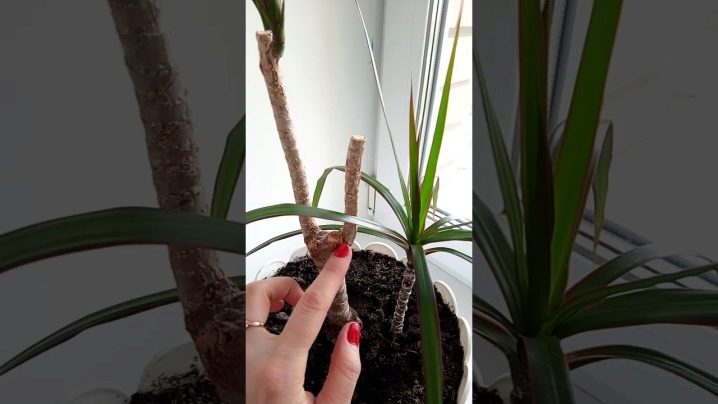
In spring, phytohormones are produced in large quantities, with the help of their lateral shoots grow faster. The incisions at these moments are transiently tightened.
Many are interested in the question of whether it is allowed to prune dracaena in winter and summer.
Florists argue that during these periods it is not worth carrying out this operation, because it is a lot of stress. The plant is dormant, and all processes are in a slowed down state. If you cut the flower at this time, the sprouts will germinate for a long time or, at all, will not appear, and the wound will heal for a long time.
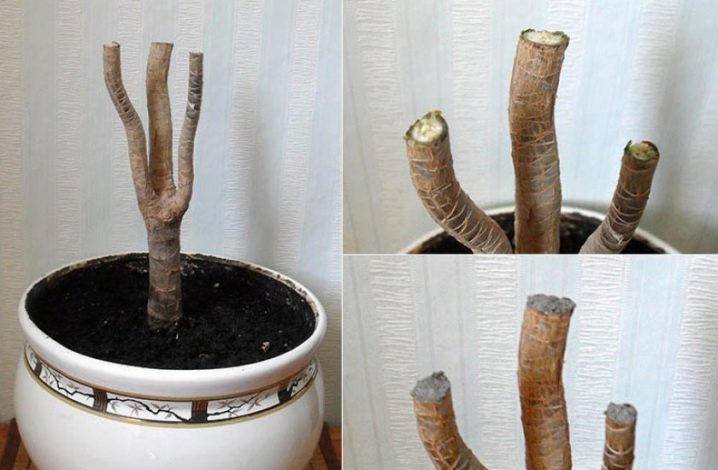
And also cutting the plant in winter or summer is possible only in case of an emergency, for example, if the plant is broken
It must be taken into account that this can be done exclusively on a healthy flower.
Further care
If you prune the dracaena in violation of the technology, then the fleshy stem of the ornamental plant begins to dry, but it is equally important to provide the indoor culture with proper care after the formation of the aboveground part. After pruning a tropical plant for good growth and full development, it is necessary to provide sufficient lighting, spraying and high-quality irrigation measures
Quite often, after pruning, the dracaena forms several buds at once, but in the end, some die, while others stop growing and development. Despite the fact that the indoor false palm tree grows rather slowly, providing proper conditions of maintenance and competent care, an amateur florist can achieve a plant height of one and a half meters or more. To activate growth processes, you will need not only the presence of sunlight and warm moist air, but also regular fertilizing with complex fertilizers.
A good result is also given by additional stimulation of the growth of lateral shoots by spraying with a solution of urea, diluted at the rate of one gram of the drug per liter of warm and settled water. Nitrogen-containing fertilizers are very well absorbed by indoor plants through the foliage. Horn shavings or bone meal can be added to the potting soil during planting. With proper care in indoor floriculture, regardless of the type, dracaena eventually grows into a very decorative and large specimen of indoor culture.
Reproduction technology at home
At home, the easiest way is to cut the top of the dracaena during the formative pruning period. After shortening the main stem, the cuttings can be kept in water until the roots appear, and then transplanted or immediately planted in the ground. Seed propagation is a longer and more troublesome process, therefore it is used much less often. Depending on the type of dracaena, the option of reproduction by air layers is possible.
Did you know? The "Explanatory Dictionary" of Vladimir Dahl mentions the original name of this plants - "dragon".
Apical cuttings
Manipulations are carried out in March, when the adult plant emerges from the dormant stage. The cut must be made with a sharp pruner, disinfected in alcohol, at a distance of 15-18 cm from the last leaf perpendicular to the trunk. Next, the stem is cleaned of old foliage and dried for 2-3 hours in the sun.
There are several ways to root a stalk:
- by placing in a solution of "Kornevin" in combination with charcoal;
- having landed in a peat-sand or vermiculite mixture.
Did you know? Dracaena extract is added to hair dye. The rich chemical composition of the juice improves the structure of the hair and prevents damage during dyeing.
The stem with roots remaining after pruning should not be thrown away. The cut point can be treated with Kornevin's solution and, covered with polyethylene, set aside in a dark place where the air temperature is maintained within + 25 ℃. After a week, the container is moved to a well-lit room (but not in direct sunlight) and standard care is provided. After a month, 2-3 lateral shoots will appear at the cut site.
Stem cuttings
If, after shortening the main stem, it is still too high, or rotting of the upper part has begun with a healthy root system, use the technology of propagation by stem cuttings. To do this, the stem must be shortened to the required height, and the resulting fragment must be cut into cuttings 10-15 cm long.
The rooting process is carried out similarly to the above. It takes 1–1.5 months for rooting, and 2–2.5 months for the emergence of apical shoots.
Air layering
In the absence of the possibility of cuttings - for example, when the plants are still low for pruning - they practice the method of propagation by air layers. To do this, you can carry out the following manipulations:
- At a distance of 2 cm from the first sheet, make a perpendicular cut to the middle of the trunk.
- Insert a toothpick into it.
- Wrap the cut with sphagnum moss and wrap with polyethylene.
- Periodically, the moss needs to be moistened with a spray bottle.
- When roots break through the moss, remove the plastic and cut off the sprout.
- Root the cuttings in the soil for adult plants, including a sod-leaf mixture, peat and sand in equal amounts.

Read more about how to properly trim dracaena at home.
Seeds
At home, dracaena flowering followed by fruiting is a rarity. But if the planting material was still received, then you should not hesitate with its embedding in the soil:
- The seeds must be peeled and placed in the Kornevin solution for 20 minutes.
- Then the planting material is dried and laid out on the surface of the sand and peat soil mixture at a distance of 5–7 cm.
- After sprinkling the seeds with dry sand, the containers are covered with polyethylene and placed in a well-lit room, where the air temperature does not drop below + 27 ℃.
- During the germination period, the planting is aired daily.
- When the sprouts reach a height of 5–7 cm, a pick is made into separate containers.

Possible pruning problems
If the dracaena has completely lost its leaves, watering should be cut, otherwise the root may rot
When exposing the plant to the light, it is important to rotate it periodically for the full development of the buds.
One of the complications of circumcision is tip decay. This happens due to infection of the injured tissue. In this case, you need to do the trimming again, below the damaged area, in compliance with all the rules.
Dracaena pruning is a necessary procedure for the tree to be healthy. Also, the plant is pruned to give it an attractive appearance.
vote
Article Rating
Dracaena to be cut
We recommend that you familiarize yourself
Often, novice growers make mistakes in the process of pruning dracaena, resulting in not a beautiful neat plant, but an almost bare tree without shoots. To prevent such unfavorable events for the flower, you first need to find out which species are suitable for pruning at home.
It is worth paying attention to the features of the species:
- 1Reflexa - unlike most species, this one is characterized by small size, the leaves are bent, and the branches go straight from the roots. The stem is practically not pronounced, in general, this species looks like a dense bush, which practically does not require pruning.
- 2Surculosis - this species looks more like a fluffy bush, its leaves are dark green with specks. This variety is especially well suited for beginner growers, because it is very easy to cut it: the plant forms many shoots. To prevent representatives of this species from growing strongly, it is enough to properly cut the top. See below for more details on such pruning.
- 3Flower - a tall tree for the home, with proper care it grows up to 3.5 m, the leaves are wavy and quite large. This species is especially common in educational institutions and offices. It is quite difficult to cut it yourself, for this you need to be an experienced florist.

These are the 3 most common species and are easy to grow at home. Can you cut the dracaena yourself? You can answer in the affirmative, but this must be done carefully. With experience and practice, pruning will be done much faster, and after a few procedures, even the fluffiest and tallest species of dracaena will be pruned.
Dracaena care after pruning
After cutting, it is important to properly handle the cut; it should be "sealed" with paraffin or wax to prevent moisture evaporation. To do this, light a candle and drop a few drops on the cut surface. If juice flows from the "wound", wipe it with cotton wool.
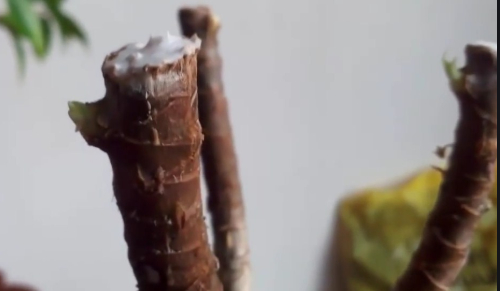
Sealed Slice
Important! The molten paraffin should not get on the leaves of the plant, so that there are no burns. It is necessary to decide on the flow of light that will fall on the plant after renewal.
This fact will also help in adjusting the future height of the stem. It is better to place a perennial near the east or west window.
It is necessary to determine the flow of light that will fall on the plant after renewal. This fact will also help in adjusting the future height of the stem. It is better to place a perennial near the east or west window.
Palm owners should know how to grow many new dracaena at once by pruning the tops. In fact, this is one of the ways of its reproduction.
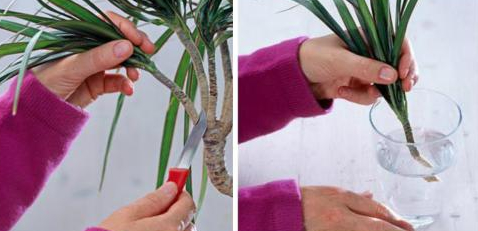
Reproduction
For this purpose, only healthy shoots are used. After drying for 48 hours, the cutting is placed in plain water, immersed in a moss pillow or hydrogel. For better germination, it is advisable to make a greenhouse from polyethylene. Root pecking occurs after about 30 days. When this happens, the plant is transplanted into stationary soil.
The need for pruning
Currently, there are several well-known main reasons for which the cutting of an indoor ornamental plant is vital:
- in order to preserve the compactness of the room dracaena;
- in order to maintain the most attractive appearance;
- for sanitary purposes.
If the false indoor palm has grown too high, almost to the ceiling, then a breakdown of the trunk is often observed, and primary pruning is used to reduce the risk of this phenomenon. In indoor floriculture conditions, strong stretching of the plant should not be allowed, therefore, the image is carried out when a height of 0.3-0.4 m is reached. The stem part is cut at the required height, which allows you to maintain compactness and an attractive appearance. A broken plant also needs to be pruned correctly.
If the already branched houseplant has grown strongly or has become insufficiently decorative, with ugly growing shoots, then the dracaena will need formative pruning. A diseased plant with dry or decaying shoots undergoes immediate sanitary pruning, which involves the removal of all diseased parts. Despite the fact that after sanitary pruning, in most cases, the plant is capable of losing its external attractiveness for a long time, such an event allows you to preserve the ornamental culture and achieve branching of lateral shoots.
Diseases and problems associated with plant cultivation
Like any houseplants, dracaena can get sick. The main problems caused by improper care are associated with leaf condition, lack of growth and pest damage. In addition to the ugly appearance, this can threaten the loss of the plant.
Why do the leaves turn yellow and the tips dry?
If the leaves turn yellow and the tips dry out, the plant is damaged by a spider mite. This is due to the overdried air in the room. Accordingly, for prevention, it is necessary to ventilate and regularly spray the ground part of the dracaena. For the treatment of a diseased plant, the drug Fufan is used. Sometimes this condition is not caused by pests, but by improper care. For example, this situation can arise due to dry air. You can solve the problem by spraying or installing a container with water near the dracaena. If only the lower leaves turn yellow and dry, then this is a natural process of their withering away, since they develop from 1.5 to 2 years. When, in addition to problems with leaves, the trunk of the plant is soft, the dracaena was flooded. To save the plant, you will need to completely change the soil. When the soil is overdried, the leaves, in addition to yellowing, become soft. Cold and draft may be another cause of this problem.
Why do leaves fall?
Dracaena leaves fall off for several reasons. For example, changing lighting, cooling, overflow, drought. Moderate leaf loss is normal. The naturalness of the process is evidenced by the fact that they previously turned yellow, turned brown and dried. From old age, the plant loses its lower leaves. When overflowing in a short time, a lot of them are lost and the trunk becomes soft. In this case, you cannot do without an emergency transplant.With a lack of water, leaves fall, which did not have time to dry completely.
Why doesn't dracaena grow?
There are also several reasons for plant growth to stop. For example, a wrong transplant. If the new pot is much larger than the old one, then the dracaena will not grow until its roots reach the walls of the container. When the plant was planted too deeply, then its growth slows down, and may even stop altogether. To stimulate it, you can use the appropriate drugs. Perhaps the dracaena has stopped growing due to lack of food. Dead roots may be another cause.
White larvae on dracaena - what to do?
White larvae on dracaena are either scale insects or mealy worms. You can start treatment with a thick soapy foam (wipe the plant after 3-5 days). If it does not help, then you will have to use ready-made preparations (fitoverm, actana and others). Treatment with alcohol helps against the worm.


